This Easy Pavlova Recipe is the ticket to pav perfection! Create a dessert that looks good and tastes sensational, with a smooth and fluffy marshmallow centre encased in a delicate and crisp meringue shell.
Top it with whipped cream and fruit, add a little ice cream if you like, and get your dessert spoon at the ready because this dessert always disappears fast.
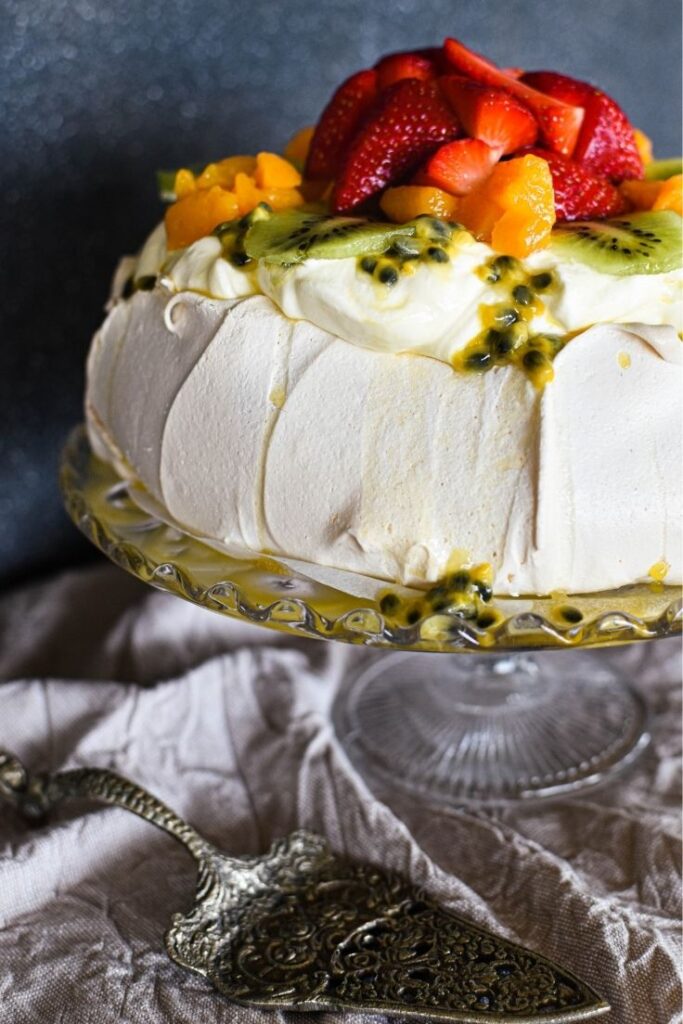
Jump to:
Why this recipe is BEST
It's a big call but I really think I can back up this claim.
If you follow the easy step-by-step instructions below, you'll create a pavlova that not only tastes exceptional but also looks absolutely perfect.
The secret to this recipe's success? Decades of pav making experience combined with Nana Ling's original recipe from 1941.
I know all the hits and misses involved – and have added everything you'll need to avoid the pitfalls that lead to weeping, cracking and other spoilers.
When it comes to taste, Nana Ling's recipe notably leaves out the cornflour that many modern recipes insist should be added. I've found the cornflour is not necessary and can add a floury taste that detracts from the overall heavenly experience of enjoying a slice of pavlova.
If you need more convincing, just ask the readers. The recipe is rated 4.9/5 and gets rave reviews, like this one:
I was terrified of making a Pavlova but followed your recipe and instructions to the letter and it was a real success, crisp but not too crisp on the outside and soft and fluffy marshmallow on the inside so a big thank you from Belfast, Northern Ireland.
Jayne
A little history
Pavlova was initially named "Pavlova Cake" and was a more elaborate cake with layers of jelly and meringue made separately.
It gradually evolved into the pavlova we now see on modern tables throughout Australia, New Zealand and the rest of the world – especially at Christmas time.
I'm going to completely bypass the Australia vs New Zealand origin argument – there's already enough fighting over pavlova at Christmas time when a few family members start eyeing the last slice!
It's generally agreed that pavlova is named after the Russian ballerina Anna Pavlova who visited Australia and New Zealand in the 1920s, but modern versions of the recipe didn't start appearing in Aussie cookbooks until the 1930s and 40s.
Which means Nana Ling's recipe, written out by hand in October 1941, is likely one of the first handwritten records of this iconic recipe.
While I've largely followed this original pavlova recipe, I recommend you keep reading this post until you reach the tested and tweaked version in the recipe card at the bottom of this post. There are plenty of hints and tips to discover as you scroll and note, in particular, that I've tweaked the cooking time slightly to suit modern ovens.
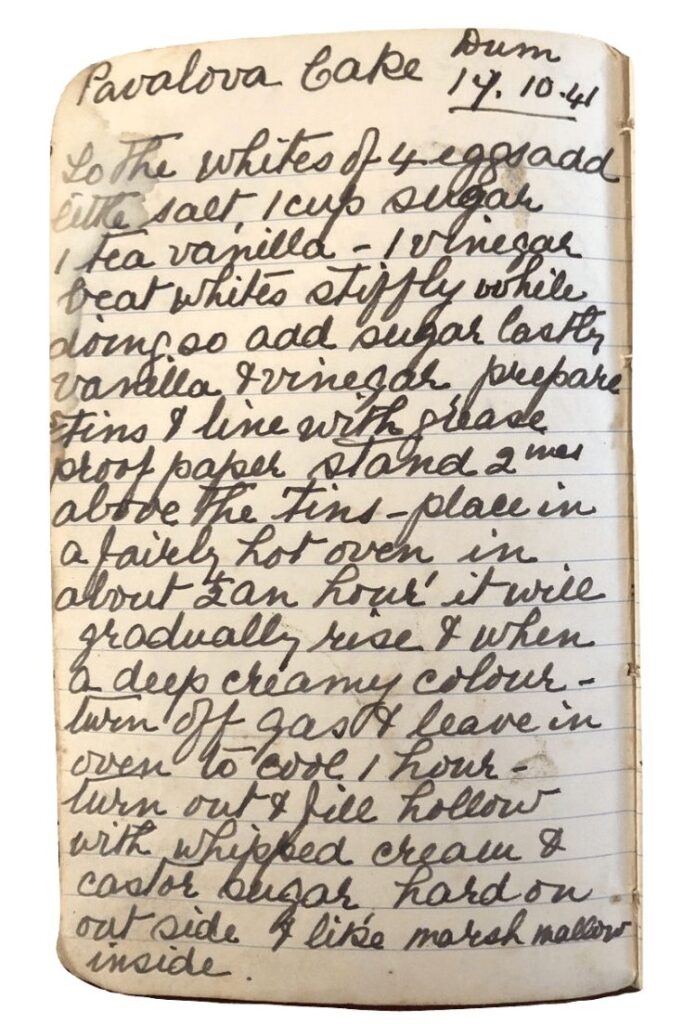
I love how you can tell this recipe is something new and different for Nana Ling by the descriptive way she writes out the method:
- "...turn off the gas when it is a deep creamy colour"
- "...hard on the outside and like marshmallow inside".
She also talks about filling the hollow with cream and leaving it in the oven to cool. These are all things we continue to do today to create an awesome pav!
Ingredient Notes
I've used the exact ingredients Nana Ling lists in her original recipe:
- egg whites
- salt
- caster sugar / superfine sugar
- vanilla extract
- white vinegar.
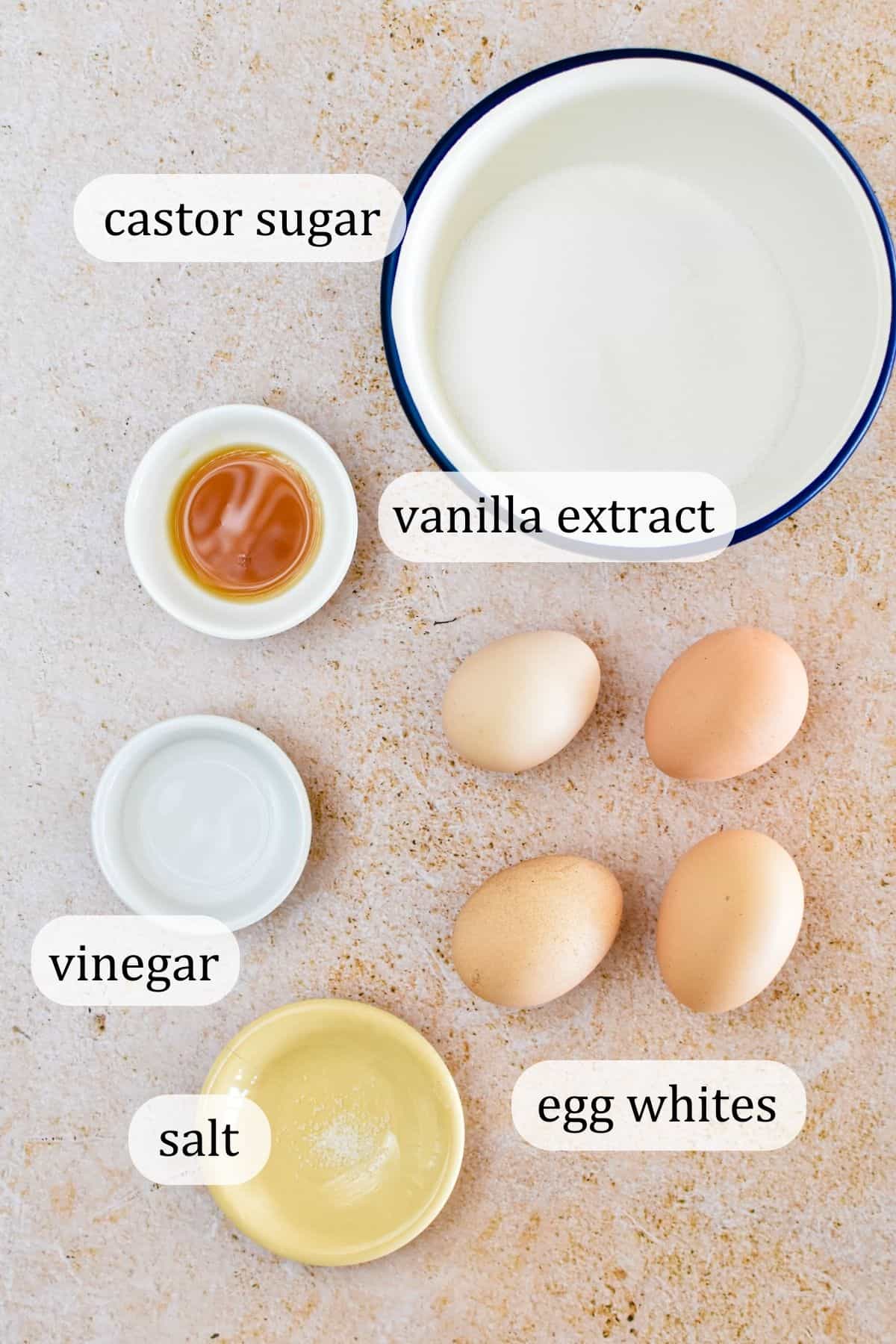
TIP: Avoid increasing the ingredient quantities as this can impact the stability of the pavlova. If you want a bigger pavlova, make two instead.
You'll also need these ingredients for decorating your pavlova:
- thickened cream / heavy cream
- icing sugar / powdered sugar
- fruit (I've used strawberries, peach, passionfruit and kiwifruit).
How to make Pavlova
Pavlovas can be a little tricky – prone to burning, cracking, collapsing and weeping.
To avoid these nasties and create something that looks wonderful and tastes even better, follow these steps and take note of all the tips along the way.
Prepping
Preheat your oven to 130 degrees celsius / 265 degrees fahrenheit (fan-forced)
Line a baking tray, round bottom from a round springform pan or round pizza tray with baking paper.
Get your mixer ready – a stand mixer or handheld electric beaters will do the job.
Also, make sure the mixing bowl is clean and dry.
It's all about the eggs
Make sure you use mid-sized eggs (60 grams) as noted in the recipe card below.
Next, don't let any of the yolk get into the white as you separate the eggs. Not a drop!
Finally, for best results, bring the whites to room temperature before beating. That means leaving them out of the fridge for about half an hour.
TIP: You'll probably find it easier to separate the eggs when they are cold, though, so do that bit when they're cold. I find the separating method using the shells only works best to separate the egg whites from the yolks.
Once you're ready to go, beat the egg whites and salt together until the mixture forms soft peaks.
TIP: Start beating on low speed and then increase to med-high speed. Don't over-beat.
Add the sugar
Make sure it's caster sugar that you're using as this will dissolve more easily into the egg mix and deliver a better overall result.
If the sugar doesn't dissolve properly, it might leak from the pavlova during the cooking process.
TIP: If you only have white/granulated sugar, use a food chopper or processor to pulse or blend until it reaches a finely ground consistency.
Add the sugar gradually while continuing to mix on low-med speed.
I add about ⅕ at a time and beat for about 20-30 seconds before adding the next portion of sugar.
Once all sugar has been added, continue to beat on med-high speed until the mixture becomes thick and glossy. It should hold its shape quite well and there should be no granules when you rub the mixture between two fingers. This should take about 2-5 minutes.
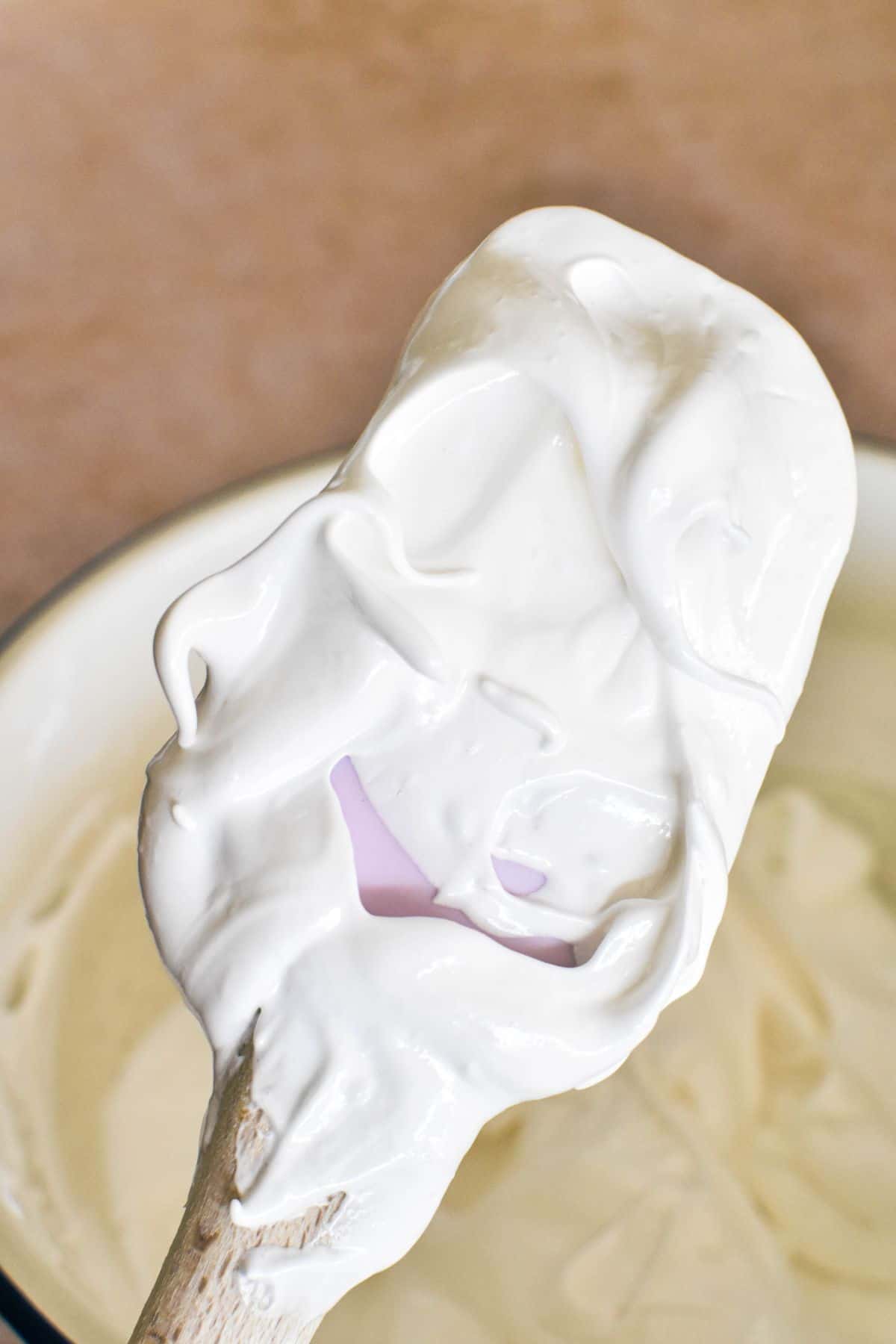
TIP: Use the whisk attachment if using a stand mixer but go easy! Take care not over-beat. More beating doesn't equal a better or fluffier pavlova. Instead, focus on achieving that thick and glossy mixture with a smooth texture – and then stop beating!
Mix in the extras
Add the vanilla extract and vinegar and mix on low speed until combined.
Shaping
Spoon the mixture onto the lined tray and use a spatula to shape the mixture into a circle about 17-20cm in diameter.
TIP: A smaller and higher pavlova looks great, but can be more fragile and difficult to bake. If you're a newbie pav maker, start with a larger pavlova (around 20cm diameter).
Flatten out the top of the pavlova using the spatula and then use the spatula to brush up the sides of the pavlova on a slight inwards lean (say 10-20 degrees). This will create a slightly domed effect and slightly concave top – helping with the stability of your pavlova.
Baking
Place the pavlova in the oven and cook for 15 minutes before reducing the oven temperature to 100 degrees celsius /210 degrees fahrenheit (fan-forced) and cooking for another 45-60 minutes.
A longer cooking time will deliver a pavlova with a good amount of crispy shell on the outside while still having that marshmallow-y centre. A shorter cooking time will create a more marshmallow-y pavlova overall.
Allow to cool
This bit is important.
Turn the oven off after cooking time elapses but DO NOT open the oven door.
Leave the pavlova to cool in the oven for at least 6 hours, preferably overnight.
Once completely cool, remove from the oven.
Decorating
It can be tricky to remove the pavlova from the baking paper. It's a super delicate dessert.
If you're new to this, perhaps just leave it on the baking paper and place on serving tray before trimming the paper.
If you're feeling confident, you can remove the pavlova from the baking paper using a metal spatula to release the pavlova from the paper and then pulling the paper out from underneath the pavlova (rather than trying to lift the delicate pavlova).
I recommend decorating with whipped cream and fruit just before serving – ideally, no more than 4 hours before serving.
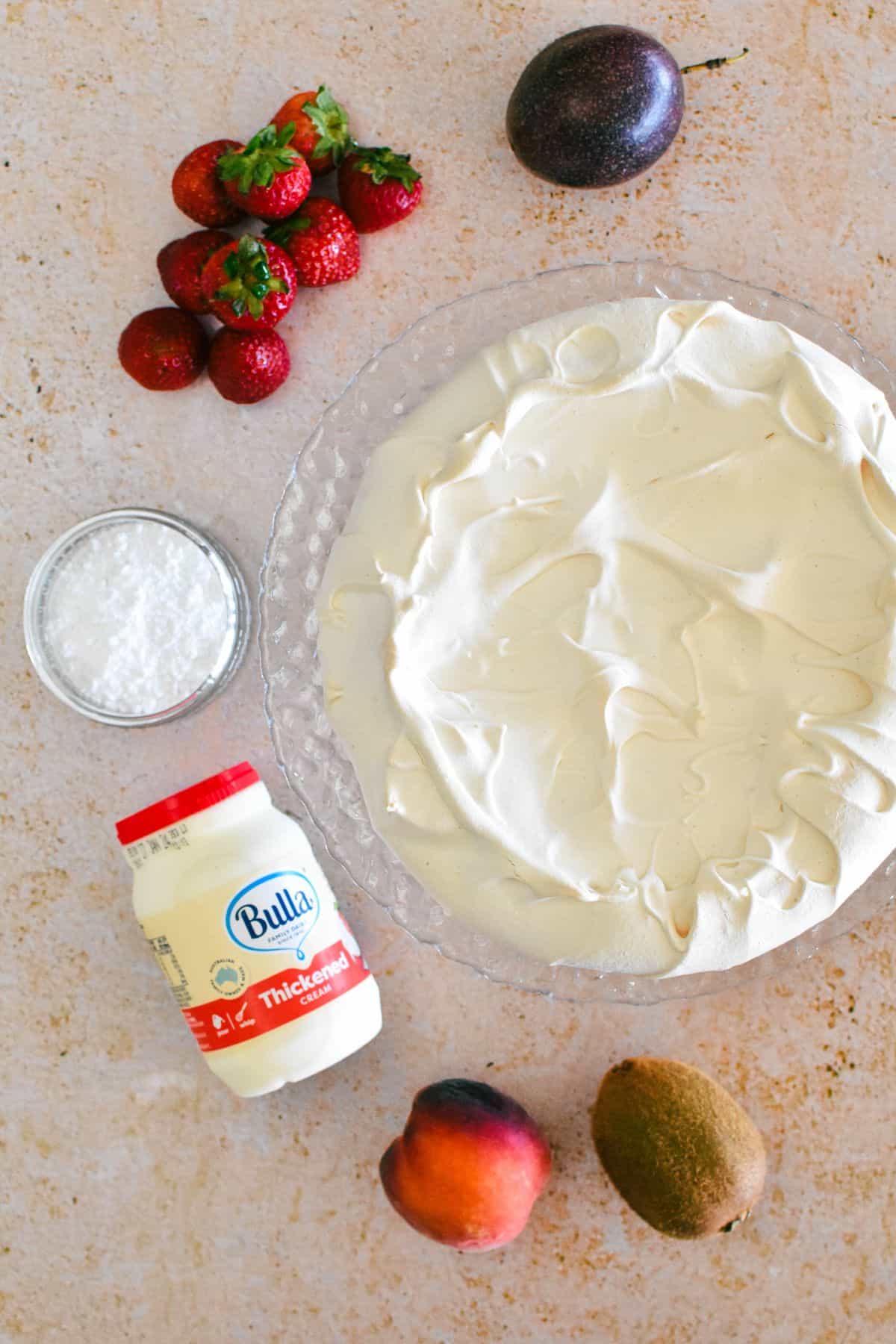
Beat the cream until soft peaks form. Add the icing sugar and beat again to combine. Spoon the cream over the top of the pavlova.
TIP: Again, avoid overbeating as cream that is too stiff is harder to spoon onto the pavlova without crushing it.
Scoop out passionfruit pulp and cut the rest of the fruit into slices/pieces. Arrange over top of cream.
You've done it!
Enjoy a slice – ice cream optional.
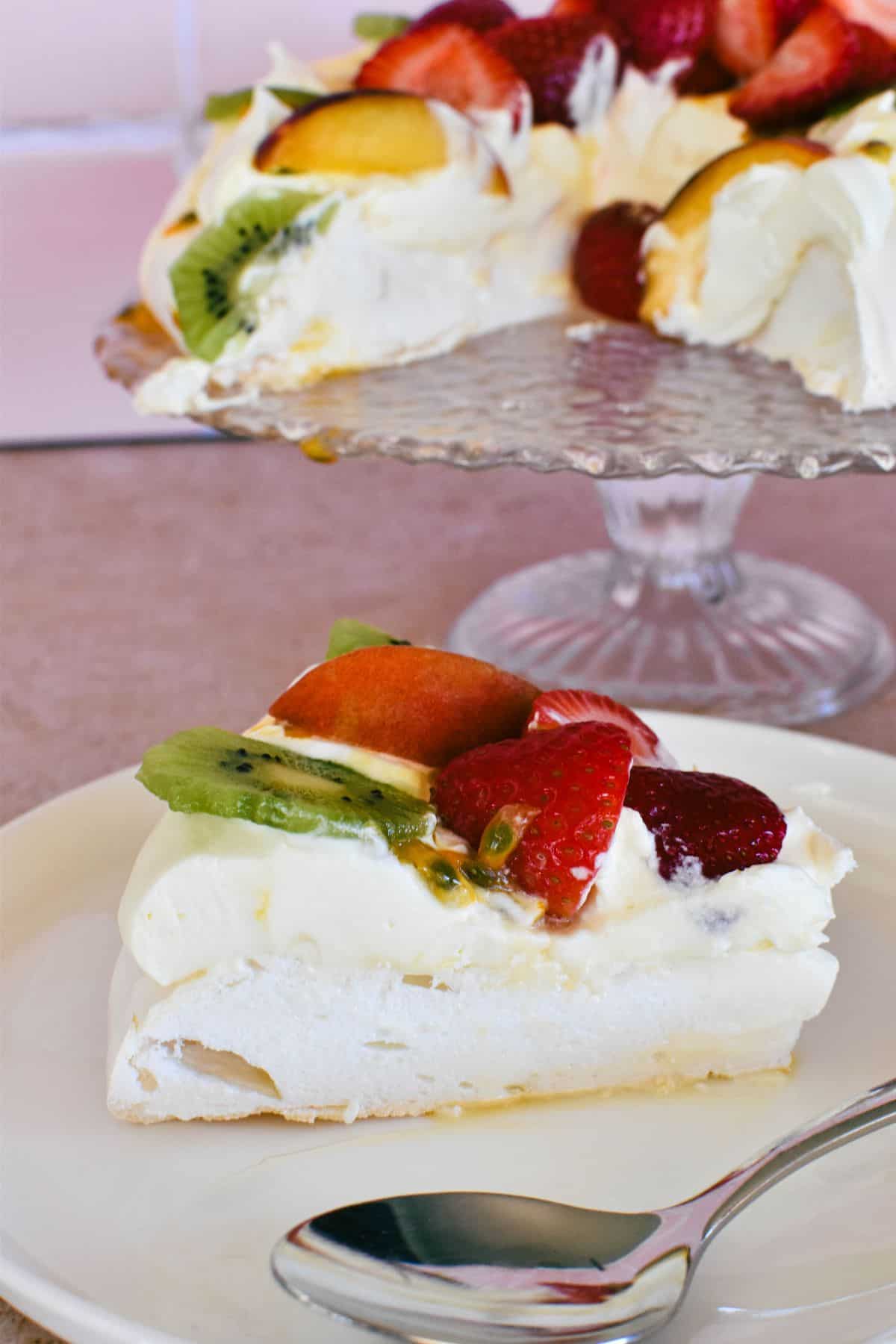
Storage
You should make your pavlova the day before and then store it in the oven to completely cool (and an airtight container once cooled.) Ideally, decorate it no more than a 4 hours before serving.
Store decorated pavlova in the fridge and enjoy leftovers (if there are any) the next day.
Pavlova doesn't freeze well.
Variation Ideas
- Use banana, berries, figs or any other fruit you fancy
- Add some flavouring to the whipped cream
- Sprinkle some shaved chocolate or dust with icing sugar.
- Try one of these recipe variations:
Top Tips
Let's summarise the most important things to keep in mind when making pavlova:
- EGGS: use 60 gram eggs, don't let any yolk get into the whites, make sure the whites are at room temperature before beating, aim for soft peaks when beating.
- SUGAR: make sure it's castor sugar and add gradually to the egg whites, about ⅕ at a time and beating for 20-30 seconds after adding.
- BEATING: Once all the sugar has been added, beat the mixture until thick and glossy and there are no sugar granules when you rub the mixture between your fingers – but don't overbeat. It should hold its shape when you form the round pavlova on the baking tray.
- REDUCING OVEN TEMP: There is a temperature drop during the cooking process, so make sure to set an alarm.
- COOL IN OVEN: once you switch off the oven, leave pavlova in there to gradually cool – it'll need at least 6 hours, preferably leave it overnight.
- MAKE TWO: I don't recommend increasing the quantities to make a larger pavlova. Make two instead!
Recipe FAQs
I find whites that I've frozen and thawed out or whites that have been separated out and left in the fridge for a day work every bit as good as completely fresh egg whites.
If it's just a few cracks, that's fine. Expect a few cracks. However, make sure you leave your pavlova in the oven to cool if there are a few too many cracks.
Also, be sure not to make the cream for decorating too stiff or it will be harder to decorate without causing even more cracks. Use the cream when decorating to hold the existing cracks together.
Your oven is too hot. Try turning it down a little next time.
There are several reasons why your pavlova may collapse.
First, you may not have whipped the eggs and sugar well enough. Make sure you achieve the thick, glossy mixture and rub a little between your fingers to make sure the sugar is dissolved.
If you open the oven door too soon after it's cooked, you also risk a collapsed pavlova.
For the time being, though, just add the cream and fruit – it'll taste just fine.
Nana Ling's original recipe from 1941 did not include cornflour and I've stuck to her exact ingredient list.
I've read various explanations as to why it is included, from preventing weeping to ensuring a marshmallow centre. This recipe works without the cornflour and in my book the pavlova tastes better since I can sometimes taste the cornflour in pavlovas that incorporate it as an ingredient.
More Iconic Aussie Recipes
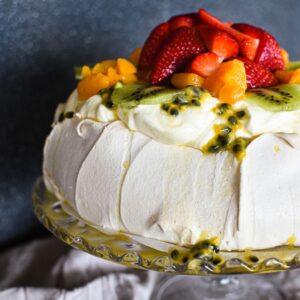
Pavlova Recipe
Equipment
- baking tray (a round pizza tray works well)
- electric hand beaters or stand mixer
Ingredients
Pavlova
- 4 egg whites (from mid-sized - approx60 gram - eggs)
- 1 pinch salt
- 1 cup caster sugar / superfine sugar (210 grams)
- 1 teaspoon vanilla extract
- 1 teaspoon white vinegar
Whipped cream
- 300 ml thickened cream / heavy cream
- 1 tablespoon icing sugar / powdered sugar
Fruit topping
- 5-7 strawberries
- 1 peach (or half a mango or tinned peaches)
- 1 passionfruit
- 1 kiwifruit
Instructions
Pavlova
- Preheat oven to 130 degrees celsius / 265 degrees fahrenheit (fan-forced)
- Line a baking tray, round bottom from a round springform pan or round pizza tray with baking paper.
- Beat egg whites and salt until the mixture forms soft peaks. (Start beating on low speed and then increase to med-high speed.)
- Add sugar gradually while continuing to mix on low-med speed.
- Once all sugar has been added, continue to beat on med-high speed until the mixture becomes thick and glossy and there should be no granules when you rub the mixture between two fingers. This should take about 2-5 minutes.
- Add vanilla extract and vinegar and mix on low speed until combined.
- Spoon mixture onto the lined tray and use a spatula to shape the mixture into a circle about 17-20cm in diameter. Flatten out the top of the pavlova using the spatula and then use the spatula to brush up the sides of the pavlova on a slight lean (say 10-20 degrees) towards the centre of the pavlova. This will create a slightly domed effect and slightly concave top – helping with the stability of your pavlova. .
- Place pavlova in oven and cook for 15 minutes before turning oven down to 100 degrees celsius / 210 degrees fahrenheit (fan-forced) and cooking for another 45-60 minutes. A longer cooking time will deliver a pavlova with a good amount of crispy shell on the outside while still having that marshmallow-y centre. A shorter cooking time will create a more marshmallow-y pavlova overall.
- Turn oven off after cooking time elapses but DO NOT open the oven door. Leave the pavlova to cool in the oven for at least 6 hours, preferably overnight.
- Once completely cool, remove from the oven.
Decorating
- You can remove the pavlova from the baking paper (use a metal spatula to release the pavlova from the paper and pull the paper out from underneath the pavlova rather than trying to lift the delicate pavlova) or leave it on the baking paper and place on serving tray before trimming the paper.
- Decorate with whipped cream and fruit just before serving.
- Beat the cream until soft peaks form. Add the icing sugar and beat again to combine. Spoon the cream over the top of the pavlova.
- Scoop out passionfruit pulp and cut the rest of the fruit into slices/pieces. Arrange over top of cream.
Video
Notes
- EGGS: use 60 gram eggs, don't let any yolk get into the whites, make sure the whites are at room temperature before beating, aim for soft peaks when beating.
- SUGAR: make sure it's castor sugar and add gradually to the egg whites, about ⅕ at a time and beating for 20-30 seconds after adding.
- BEATING: Once all the sugar has been added, beat the mixture until thick and glossy and there are no sugar granules when you rub the mixture between your fingers – but don't overbeat. It should hold its shape when you form the round pavlova on the baking tray.
- REDUCING OVEN TEMP: There is a temperature drop during the cooking process, so make sure to set an alarm.
- COOL IN OVEN: once you switch off the oven, leave pavlova in there to gradually cool – it'll need at least 6 hours, preferably leave it overnight.
- MAKE TWO: I don't recommend increasing the quantities to make a larger pavlova. Make two instead!

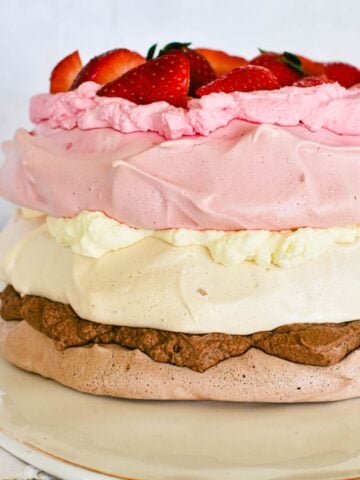
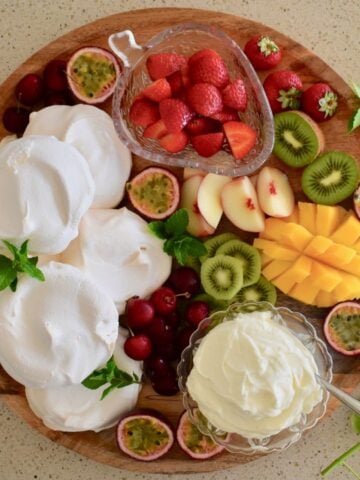
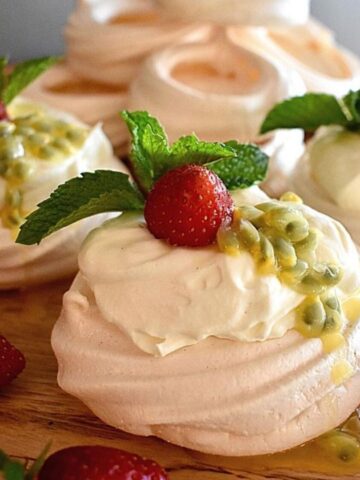
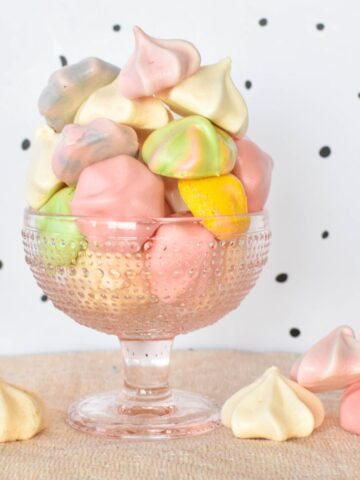
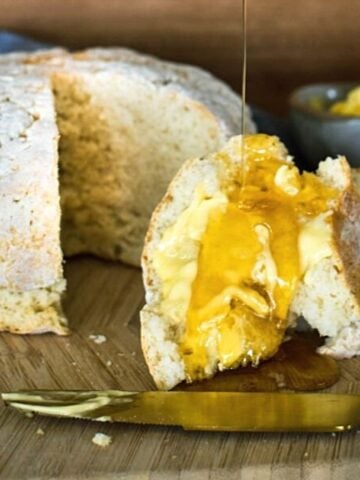
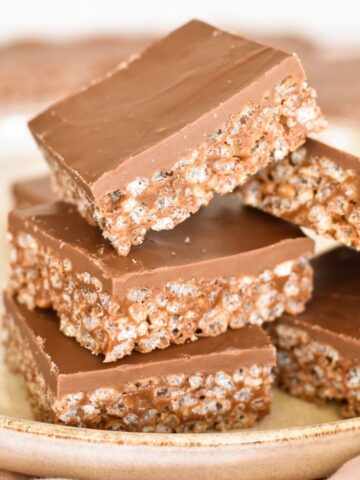
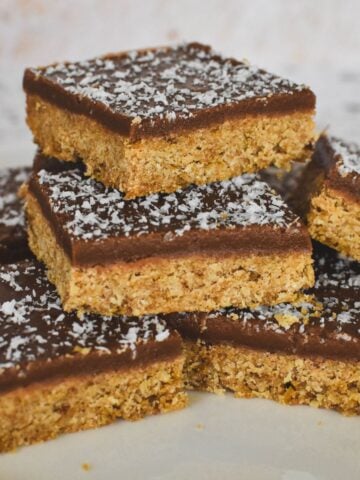
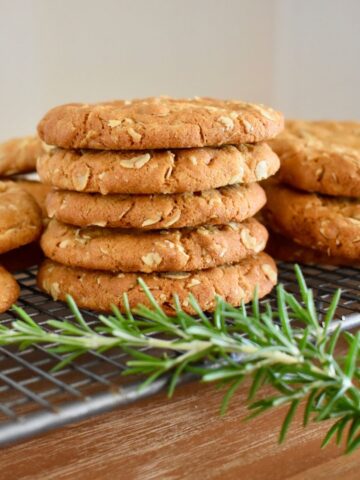
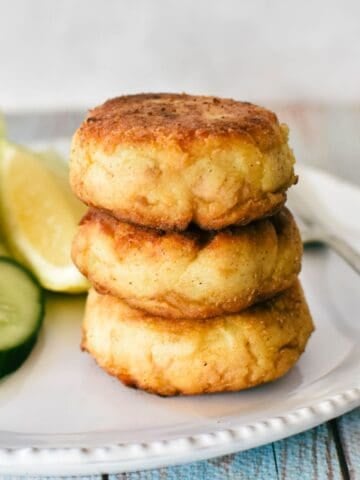
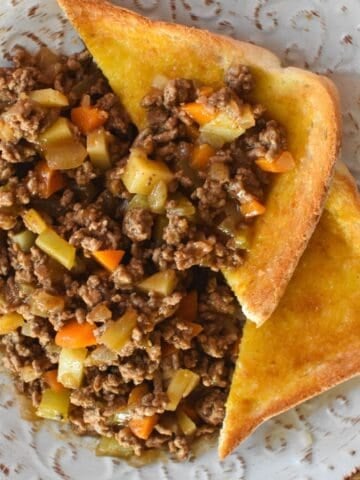
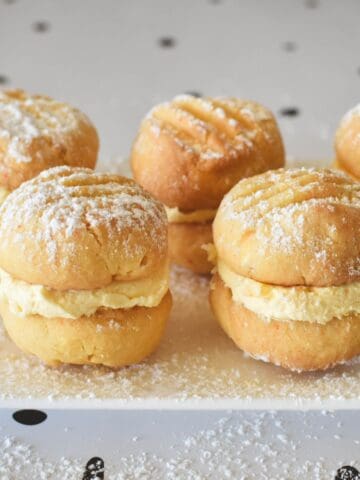
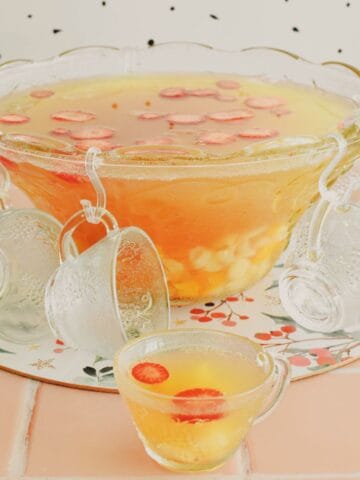
Angela
Hello,
I am just wanting clarification of the temperatures.
Is the preheat 130 (fan forced) which is equivalent to 150 C non-fan?
Likewise when the temperature is turned down to 100 C fan forced therefore 120C non-fan?
Looking forward to hearing from you.
Regards, Angela
Libby Hakim
Hi Angela. It really depends on the oven. The guide is generally 20 degrees up for non-fan, however these days I find it's closer to 10 degrees. I'd try that first with pavlova. Good luck!
Sharon
Scrapping up to 50cm ???
Libby Hakim
haha - I just mean to get the right angle! Not to actually make the mixture reach up 50cm (that'd be a tall pav!!) Perhaps I'll find a way to re-phrase that. Thanks, Sharon 🙂
Jayne
I am very new to baking despite being in the wrong side of 50! I was terrified of making a Pavlova but followed your recipe and instructions to the letter and it was a real success, crisp but not too crisp on the outside and soft and fluffy marshmallow on the inside so a big thank you from Belfast, Northern Ireland. I really wish I could upload a picture.
Libby Hakim
Amazing! Thanks so much for your review and rating, Jayne. I love this recipe and it's wonderful to hear people from (very, very) afar enjoying Nana Ling's recipes. I'd love to see the picture - you can tag me on Instagram @cookingwithnanaling, find me on Facebook or email hello@cookingwithnanaling.com. Enjoy x
Elizabeth
I have decorated one with strawberries and raspberries marinated in a small amount of rose water, sprinkled with pistachio slivers and topped with Persian Fairy Floss it looks spectacular! Extra Persian Fairy Floss in a bowl on the table, as it’s sure to go!
Libby Hakim
Hi Elizabeth. Sounds amazing! Would be perfect for a birthday or Christmas. Thanks for your suggestions 🙂
Sandra
How do you make a pavlova that isn’t soft inside - more crunchy, similar to the little store bought ones.
Libby
Hi Sandra. Those little store bought ones are more like meringues than pavlova. From what I understand, you just use egg whites and sugar to make these - omit the rest of the ingredients. And you would probably cook them a little longer (though if you're making small shells you'd have to reduce time to take account of size too). I don't have a meringue recipe on the site (yet) - sorry - but you could try the pav recipe like I've suggested. Good luck!
Brenda Brazendale
I am 84 years old and Nana Ling’s pavlova is very similar to the one I have always made but using 6 egg whites, 1-1/2 cups caster sugar, 1 teaspoon vanilla essence, pinch salt, 2 teaspoons white vinegar and 1 dessertspoon cornflour. Only difference really is the cornflour. I beat 3/4 of the sugar in when the egg whites have started peaking and then I fold remainder of sugar plus cornflour (combined) in right at the end. Yes, old recipes certainly still have an important place in our cooking! You
Libby
Hi Brenda. Thanks so much for sharing your recipe. It's always lovely to hear from people who are using the recipes and looking over the website. The old recipes are definitely something to hang on to and it just feels comforting to know that we are following recipes that were part of the lives of our mothers, grandmothers, great grandmothers and so on. Libby x
Sylvie
Such a classic dessert, and I loved reading its history! Thanks for all the great tips to make pavlova too 🙂
Libby
Hi Sylvie. Thanks for your lovely comments. Pavlova does indeed have an interesting history and is one of my most-loved sweets. Thanks again for commenting (and I'm loving following your blog - your photography is wonderful). Libby x